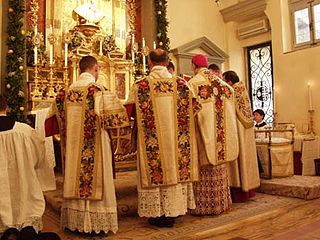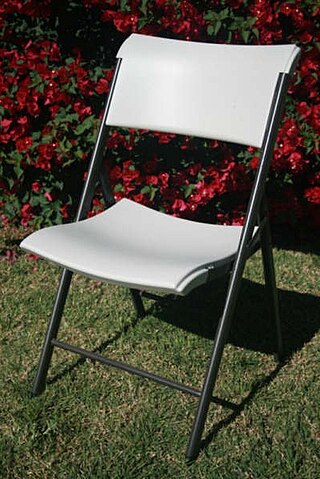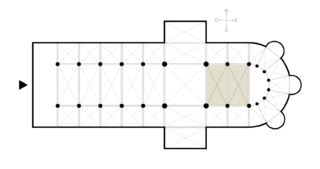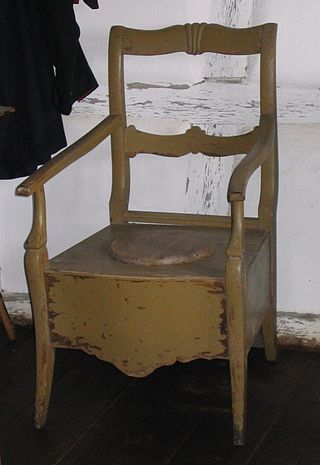
A seat is a place to sit. The term may encompass additional features, such as back, armrest, head restraint but also headquarters in a wider sense.

An episcopal see is, in a practical use of the phrase, the area of a bishop's ecclesiastical jurisdiction.

A throne is the seat of state of a potentate or dignitary, especially the seat occupied by a sovereign on state occasions; or the seat occupied by a pope or bishop on ceremonial occasions. "Throne" in an abstract sense can also refer to the monarchy or the Crown itself, an instance of metonymy, and is also used in many expressions such as "the power behind the throne".

A Pontifical High Mass, also called Solemn Pontifical Mass, is a Solemn or High Mass celebrated by a bishop using certain prescribed ceremonies. Although in modern English the word "pontifical" is almost exclusively associated with the pope, any bishop may be properly called a pontiff. Thus, the celebrant of a Pontifical High Mass may be the pope, any bishop or any other prelate who is allowed to wear pontificals.

A cathedra is the raised throne of a bishop in the early Christian basilica. When used with this meaning, it may also be called the bishop's throne. With time, the related term cathedral became synonymous with the "seat", or principal church, of a bishopric.

Janet "Jenny" Geddes was a Scottish market-trader in Edinburgh who is alleged to have thrown a stool at the head of the minister in St Giles' Cathedral in objection to the first public use of the Church of Scotland's 1637 edition of the Book of Common Prayer in Scotland. The act is reputed to have sparked the riot that led to the Wars of the Three Kingdoms, which included the English Civil War.
Chairs are known from Ancient Egypt and have been widespread in the Western world from the Greeks and Romans onwards. They were in common use in China from the twelfth century, and were used by the Aztecs. In Sub-Saharan Africa, chairs were not in use before introduced by Europeans.

A prie-dieu is a type of prayer desk primarily intended for private devotional use, but which may also be found in churches. A similar form of chair in domestic furniture is called "prie-dieu" by analogy. Sometimes, a prie-dieu will consist only of the sloped shelf for books without the kneeler.

A curule seat is a design of a (usually) foldable and transportable chair noted for its uses in Ancient Rome and Europe through to the 20th century. Its status in early Rome as a symbol of political or military power carried over to other civilizations, as it was also used in this regard by kings in Europe, Napoleon, and others.

An enthronement is a ceremony of inauguration, involving a person—usually a monarch or religious leader—being formally seated for the first time upon their throne. Enthronements may also feature as part of a larger coronation rite.

Glastonbury chair is a nineteenth-century term for an earlier wooden chair, usually of oak, possibly based on a chair made for Richard Whiting, the last Abbot of Glastonbury, England. The Glastonbury chair was known to exist since the Early Middle Ages, but seems to have disappeared from use in part of the Later Middle Ages; it re-emerged in use in Italy by the fifteenth century AD.

A deckchair is a folding chair, usually with a frame of treated wood or other material. The term now usually denotes a portable folding chair, with a single strip of fabric or vinyl forming the backrest and seat. It is meant for leisure, originally on the deck of an ocean liner or cruise ship. It is easily transportable and stackable, although some styles are notoriously difficult to fold and unfold. Different versions may have an extended seat, meant to be used as a leg rest, whose height may be adjustable; and may also have arm rests.

A folding chair is a type of folding furniture, a light, portable chair that folds flat or to a smaller size, and can be stored in a stack, in a row, or on a cart.

A choir, also sometimes called quire, is the area of a church or cathedral that provides seating for the clergy and church choir. It is in the western part of the chancel, between the nave and the sanctuary, which houses the altar and Church tabernacle. In larger medieval churches it contained choir-stalls, seating aligned with the side of the church, so at right-angles to the seating for the congregation in the nave. Smaller medieval churches may not have a choir in the architectural sense at all, and they are often lacking in churches built by all denominations after the Protestant Reformation, though the Gothic Revival revived them as a distinct feature.

Coronations in Norway were held from 1164 to 1906, mostly in the Nidaros Cathedral in Trondheim. Although a crowning ceremony was formerly mandated by the nation's constitution, this requirement was eliminated in 1908. However, Norwegian kings have since chosen voluntarily to take part in a ritual of "benediction" to mark their accession to the throne, during which the crown is present, but not physically bestowed upon the sovereign. The new ceremony retains some of the religious elements of earlier rites, while eliminating other features now considered to be "undemocratic".

An analogion is a lectern or slanted stand on which icons or the Gospel Book are placed for veneration by the faithful in the Eastern Orthodox Church and Eastern Catholic Churches. It may also be used as a lectern to read from liturgical books during the divine services.

A close stool was an early type of portable toilet, made in the shape of a cabinet or box at sitting height with an opening in the top. The external structure contained a pewter or earthenware chamberpot to receive the user's excrement and urine when they sat on it; this was normally covered (closed) by a folding lid. "Stool" has two relevant meanings: as a type of seat and as human feces. Close stools were used from the Middle Ages until the introduction of the indoor flush toilet.

A stool is a raised seat commonly supported by three or four legs, but with neither armrests nor back a backrest, and typically built to accommodate one occupant. As some of the earliest forms of seat, stools are sometimes called backless chairs despite how some modern stools have backrests. Folding stools can be collapsed into a flat, compact form typically by rotating the seat in parallel with fold-up legs.

The Coronation of the Emperor of Brazil was the religious act of consecration during which the monarchs of the Empire of Brazil were solemnly blessed, anointed, crowned, invested with the other items of the imperial regalia and enthroned, according to the usages of the Catholic Church, the Empire's official, established Church. The coronation of the Brazilian monarch confirmed the accession of a new emperor to the throne, and corresponded to similar rites that took place in other Christian monarchies. The two Brazilian emperors, Pedro I and Pedro II underwent the ceremony of coronation, on 1 December 1822 and 18 July 1841, respectively. Those remain the two sole acts of coronation that took place in the South American continent.



















